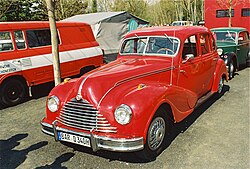 | |
| Formerly | BMW |
|---|---|
| Industry | Automobile and motorcycle manufacture |
| Founded | c. 1945 Eisenach, East Germany |
| Defunct | During the 1950s |
| Successor | BMW Opel Eisenach (factory) |
| Headquarters | |
| Products | Automobiles Motorcycles |
Eisenacher Motorenwerk (EMW) was an East German manufacturer of automobiles and motorcycles based in Eisenach. EMW also entered Formula One as a constructor in 1953, but participated in only one race, the 1953 German Grand Prix. The car retired after 12 laps with exhaust problems. [1]

